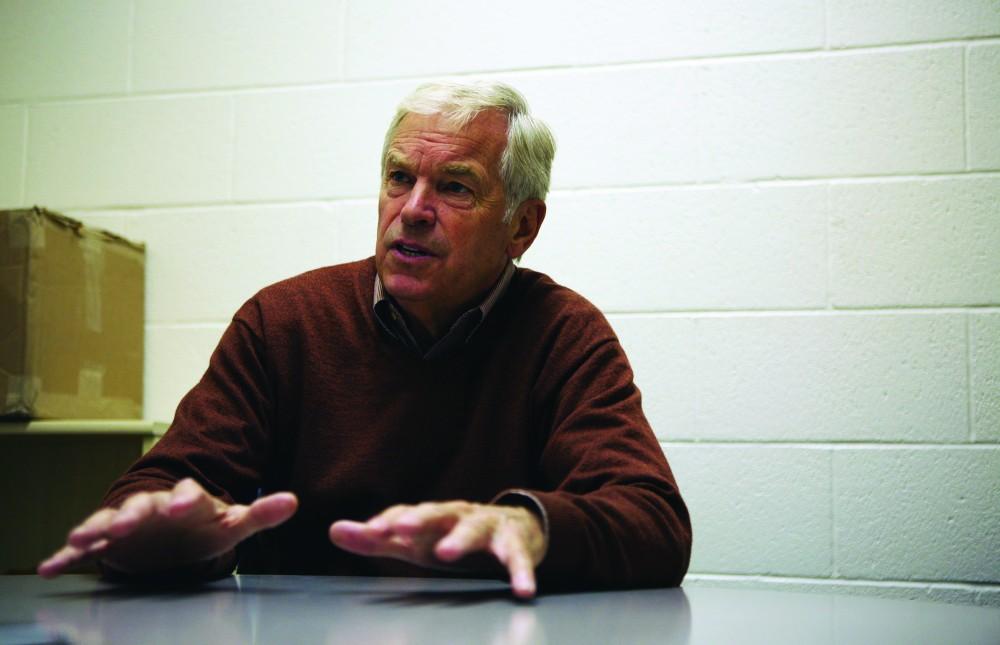GV faculty hiring slowed by limited state funding

GVL / Robert Mathews Assistant Vice President of Academic Affairs Jon Jellema speaking on the hiring process at GVSU.
Sep 30, 2012
Grand Valley State University typically hires about 50 new faculty members each year, with most of them replacing old professors and a few filling new positions. This year, however, the university hired only about 30 new members.
“We’re still replacing people, but we’ve slowed down on having new positions,” said Linda Yuhas of Human Resources. Yuhas said GVSU continues to create some new positions to keep up with an increase in the student population, but fewer new positions have been needed each year.
“As the overall size of the student body is leveling off, and as the state continues to fund Grand Valley at the lowest level of the state universities, the resources for brand new lines have leveled off a little, too,” said Fred Antczak, dean of the College of Liberal Arts and Sciences. “People will continue to retire—some people expect that if the economy comes around, we have a slightly larger number of pent-up retirements that will start happening. And it is still a strategic priority of the university to increase the percentage of tenure-track courses. So we’ll keep hiring, mostly at a pace determined by need.”
However, some at the university think GVSU is behind in the number of faculty members it offers and that it would likely hire more if it had increased state funding.
“I think we still have some catching up to do, honestly,” said Jon Jellema, associate vice president for Academic Affairs. “We’re not where we need to be in terms of the number of full-time faculty.”
But GVSU must make do with its limited resources. Jellema said sometimes colleges request more new faculty members than the university can afford, so compromises are made.
“It’s all based on where’s the need, where are the bottlenecks, where are we having trouble when we look at enrollment, and what’s preventing students from graduating on time,” he said.
As the dean of CLAS, which encompasses many disciplines, Antzcak must decide which department needs new faculty members the most.
“We have a process in which the department requesting resources has to make its best case by some specific criteria,” he said. “The department’s request to search has to address how a line would advance their strategic plan, the college’s plan and the university’s plan. They need to give us the data about need and demand. They also need to give us a detailed mentoring plan for each new faculty member.”
The dean added that, to be economical in hiring, the university carefully considers whether specific positions need to be filled upon faculty retirement.
“When someone leaves or retires, we reconsider the need for and nature of that position,” he said. “We try to put our scarce resources first toward meeting the most immediate and urgent needs of our students.”
If a need is perceived, the faculty-hiring process is lengthy and involves many different departments within the university.
In all, the process takes about an entire academic year. Based on enrollment trends, GVSU projects the number of positions it needs filled and advertises in September. Department search committees then receive and review hundreds of applications throughout the fall semester, and they deliver the narrowed choices to HR, which will check the legality of the process.
Once HR approves the selections as having been fair and equal opportunity, the departments invite the candidates to campus during the holiday break. The candidates then attend interviews in January and February, and recommendations are sent to the deans.
From there, paperwork goes through HR, Affirmative Action and the provost’s office to approve the salary suggested by the dean and ensure that the candidate was selected for the right reasons, namely their credentials but also their teaching abilities.
Jellema said most faculty members make a considerable effort to watch candidates in their demonstrative teaching. “That becomes a key piece of the whole interview process,” he said.
But in the end, “it’s the ability to teach and the evidence of scholarship” that GVSU looks for in prospective teachers.
GVSU also requires a certain level of academic achievement. Jellema said it’s rare to hire a professor without graduate school training, but some with only bachelor’s degrees are hired in as part-time adjuncts.
“The standard is we’re looking for somebody who is fresh out of graduate school for different reasons,” he said. “One of them is, there is interest in getting the most up-to-date experience and research that’s available, and typically that’s the person that’s just gone to graduate school and just been exposed to whatever the latest thinking is.”
Professors are usually hired in at the position of assistant professor, but Jellema said some will bring in years toward tenure from other universities. If candidates do come in with tenure or years toward tenure, they could potentially be hired in at the rank of associate or full professor. However, that situation is pretty unusual, Jellema said.
Although most candidates enter the university at the same position, they don’t all start out on the same salary. “Each discipline has a different market, and that is something that we look at very closely,” Yuhas said. “They’re all at the rank of assistant professor, but an assistant professor in, let’s say, English makes a very different salary than an assistant professor in finance, just because that’s what the market would pay. That’s what we have to pay to get good people, to be market driven.”
Yuhas said one issue HR reviews is whether the new hire’s salary will cause compression in the departments. That is, if a new professor is worth more in the market than it had been in the past and experienced professors currently receive less than the recommendation, GVSU might have to raise salaries of other professors to keep fairness and consistency.
For more information about GVSU’s hiring process, visit www.gvsu.edu/hro.

























